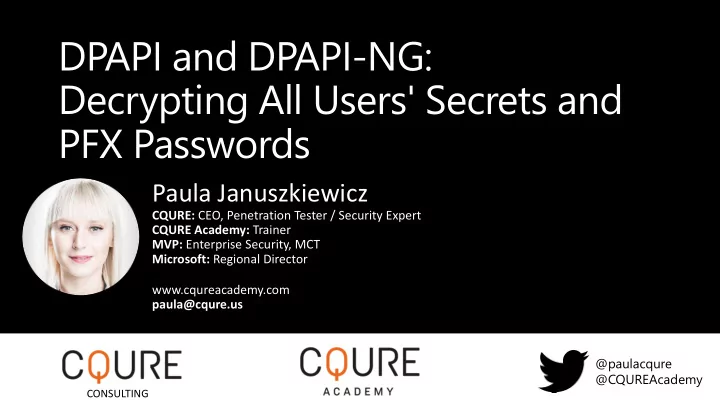

DPAPI and DPAPI-NG: Decrypting All Users' Secrets and PFX Passwords Paula Januszkiewicz CQURE: CEO, Penetration Tester / Security Expert CQURE Academy: Trainer MVP: Enterprise Security, MCT Microsoft: Regional Director www.cqureacademy.com paula@cqure.us @paulacqure @CQUREAcademy CONSULTING
Class names for keys from HKLM\SYSTEM\CCS\Control\Lsa HKLM\SECURITY\Policy\Secrets HKLM\SECURITY\Cache HKLM\SECURITY\Policy\Secrets @paulacqure @CQUREAcademy
Classic Data Protection API Based on the following components: Password, data blob, entropy Is not prone to password resets! Protects from outsiders when being in offline access Effectively protects users data Stores the password history You need to be able to get access to some of your passwords from the past Conclusion: OS greatlyhelpsus to protectsecrets @paulacqure @CQUREAcademy
Getting the: Classic DPAPI Secrets DPAPI (classic) A. MasterKey 1. pwdhash = MD4(password) or SHA1(password) 2. pwdhash_key = HMACSHA1(pwdhash, user_sid) 3. PBKDF2(…, pwdhash_key ,…), another elements from the file. Windows 10 no domain: SHA512, AES-256, 8000 rounds 4. Control – HMACSHA512 B. CREDHIST 1. pwdhash = MD4(password) or SHA1(password) 2. pwdhash_key = HMACSHA1(pwdhash, user_sid) 3. PBKDF2(…, pwdhash_key ,…), another elements from the file. Windows 10 no domain: SHA512, AES-256, 8000 rounds 4. Control – HMACSHA512 C. DPAPI blob Algorithms are written in the blob itself. @paulacqure @CQUREAcademy
Classic DPAPI Flow: getting the system’s secrets (easy) @paulacqure @CQUREAcademy
IIS Configuration / Application Pools Used to group one or more Web Applications Purpose: Assign resources, serve as a security sandbox Use Worker Processes (w3wp.exe) Their identity is defined in Application Pool settings Process requests to the applications Passwords for AppPool identity can be ’decrypted’ even offline They are stored in the encrypted form in applicationHost.config Conclusion: IIS relies it’s security on Machine Keys (Local System) @paulacqure @CQUREAcademy
DPAPI + AD CLIENT AD SERVER RPC Call Local LSASS process LSASS process BackupKey(masterkey) (local masterkey can’t be decrypted) Decrypted masterkey CryptUnprotectData() G$BCKUPKEY_PREFERRED G$BCKUPKEY_940db612-ee8f-4a31-84b3-8f80c25be855 DPAPI Scenario: offline changed user password or local masterkey can’t be decrypted 01 00 00 00 d0 8c 9d df 01 15 d1 11 8c 7a 00 c0 4f c2 97 eb 01 00 00 00 ...... DPAPI-PROTECTED BLOB @paulacqure @CQUREAcademy
Cached Logons There is actually not much of a difference with XP / 2003! No additional salting. PBKDF2 introduced a new variable: the number of iterations SHA1 with the same salt as before (username). @paulacqure @CQUREAcademy
Getting the: cached data MSDCC2 1.bootkey: classes from HKLM\SYSTEM\CCS\Control\Lsa + [class names for: Data, GBG, JD, Skew1] (+arrays’ permutations) int[] permutationBootKey = new int[] { 0x8, 0x5, 0x4, 0x2, 0xb, 0x9, 0xd, 0x3, 0x0, 0x6, 0x1, 0xc, 0xe, 0xa, 0xf, 0x7 }; 2.PolEKList: HKLM\SECURITY\Policy\PolEKList [default value] 3.lsakey: AES_DECRYPT(key, data) -> AES(bootkey, PolEKList) 4.NL$KM secret: HKLM\SECURITY\Policy\Secrets\NL$KM 5.nlkm_decrypted: AES_DECRYPT(lsakey, NL$KM secret) 6.Cache_Entry{id} -> HKLM\SECURITY\Cache\NL${id} 7.cache_entry_decrypted -> AES_DECRYPT(nlkm_decrypted, Cache_Entry{id}) @paulacqure @CQUREAcademy
Legend DK = PBKDF2(PRF, Password, Salt, c, dkLen) Microsoft’s implementation: MSDCC2= PBKDF2(HMAC-SHA1, DCC1, username, 10240, 16) @paulacqure @CQUREAcademy
Classic DPAPI Flow: getting the user’s secrets @paulacqure @CQUREAcademy
Retrieving Golden Key from LSA – Mimikatz’ way LSASRV.DLL LSASS.EXE MEMORY G$BCKUPKEY_PREFERRED LSASRV.DLL, LSASS.EXE, etc. G$BCKUPKEY_940db612-ee8f-4a31-84b3-8f80c25be855 PATTERNS (for different versions of modules) GoldenKey.pfx @paulacqure @CQUREAcademy
Retrieving Golden Key from LSA – CQURE’s way LSASRV.DLL LSASS.EXE MEMORY G$BCKUPKEY_PREFERRED G$BCKUPKEY_940db612-ee8f-4a31-84b3-8f80c25be855 ? ? ? ? ? ? ? AD secret? HOW?! GoldenKey.pfx CQLsassSecretsDumper @paulacqure @CQUREAcademy
DPAPI-AD: How (the hell) did we do it? Dude, look in DomainKey contains some GUID and the AD... 256-byte len secret – RSA?? @paulacqure @CQUREAcademy
Demo: What about KeePass? @paulacqure @CQUREAcademy
DPAPI in pictures Example: KeePass ProtectedUserKey.bin The master password for KeePass files encrypted & stored as cipherText (80 bytes) Legend @paulacqure @CQUREAcademy
Demo: What about RDP Connections? @paulacqure @CQUREAcademy
Getting the: DPAPI-NG Secrets DPAPI-NG A. RootKey Algorithms Key derivation function: SP800_108_CTR_HMAC (SHA512) Secret agreement: Diffie-Hellman B. DPAPI blob Key derivation: KDF_SP80056A_CONCAT After getting the key, there is a need for decryption: Key wrap algorithm: RFC3394 (KEK -> CEK) Decryption: AES-256-GCM (CEK, Blob) @paulacqure @CQUREAcademy
DPAPI-NG: Data encryption flow CLIENT AD SERVER RPC Call Local LSASS process LSASS process GetKey(SID, L0, L1, L2 params) NCryptUnprotectSecret() CNG DPAPI Group key RootKeyData? RootKey ACTIVE DIRECTORY SID-PROTECTED BLOB @paulacqure @CQUREAcademy
DPAPI-NG: Protected data encoded as ASN.1 blob KEK (Key Encryption Key) • Looks familiar? It should! stored as DPAPI blob It’s DPAPI blob! Forced by protection • descriptor LOCAL=user Key Wrap (RFC3394) Protection descriptor: LOCAL=user • contains encrypted CEK (Content Encryption Key) Data encrypted by CEK • @paulacqure @CQUREAcademy
DPAPI-NG: getting to SID- Protected PFX files @paulacqure @CQUREAcademy
DPAPI-NG: getting to ASP.NET secrets @paulacqure @CQUREAcademy
CQURE DPAPI Toolkit Tool Description CQMasterKeyAD DPAPIBlobCreator CQDPAPIKeePassDBDecryptor DPAPINGDecrypter CQDPAPIEncDec CQAspNetCoreDecryptData. CQDPAPIExportPFXFromAD CQAspNetCoreMasterKeyCreate CQRDCManDecrypter CQAspNetCoreEncryptData CQDPAPINGPFXDecrypter CQDPAPINGDNCoreMasterKeyDecrypter *CQImpersonateWithSeTcb @paulacqure @CQUREAcademy
Q and A Time! Let’s move to Facebook or email!
Thank You! If you have questions you can email me at paula@cqure.us You can also chat us up on the page https://cqureacademy.com/
Recommend
More recommend